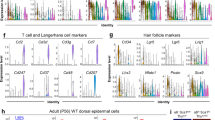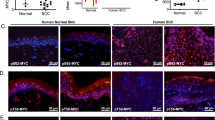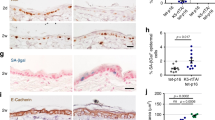Abstract
To examine the role of telomeric repeat-binding factor 2 (TRF2) in epithelial tumorigenesis, we characterized conditional loss of TRF2 expression in the basal layer of mouse epidermis. These mice exhibit some characteristics of dyskeratosis congenita, a human stem cell depletion syndrome caused by telomere dysfunction. The epidermis in conditional TRF2 null mice exhibited DNA damage response and apoptosis, which correlated with stem cell depletion. The stem cell population in conditional TRF2 null epidermis exhibited shorter telomeres than those in control mice. Squamous cell carcinomas induced in conditional TRF2 null mice developed with increased latency and slower growth due to reduced numbers of proliferating cells as the result of increased apoptosis. TRF2 null epidermal stem cells were found in both primary and metastatic tumors. Despite the low-grade phenotype of the conditional TRF2 null primary tumors, the number of metastatic lesions was similar to control cancers. Basal cells from TRF2 null tumors demonstrated extreme telomere shortening and dramatically increased numbers of telomeric signals by fluorescence in situ hybridization due to increased genomic instability and aneuploidy in these cancers. DNA damage response signals were detected at telomeres in TRF2 null tumor cells from these mice. The increased genomic instability in these tumors correlated with eightfold expansion of the transformed stem cell population compared with that in control cancers. We concluded that genomic instability resulting from loss of TRF2 expression provides biological advantages to the cancer stem cell population.
This is a preview of subscription content, access via your institution
Access options
Subscribe to this journal
Receive 50 print issues and online access
$259.00 per year
only $5.18 per issue
Buy this article
- Purchase on Springer Link
- Instant access to full article PDF
Prices may be subject to local taxes which are calculated during checkout








Similar content being viewed by others
References
de Lange T . Shelterin: the protein complex that shapes and safeguards human telomeres. Genes Dev 2005; 19: 2100–2110.
van Steensel B, Smogorzewska A, de Lange T . TRF2 protects human telomeres from end to end fusions. Cell 1998; 92: 401–413.
Karlseder J, Broccoli D, Dai Y, Hardy S, de Lange T . p53 and ATM dependent apoptosis induced by telomeres lacking TRF2. Science 1999; 283: 1321–1324.
Smogorzewska A, de Lange T . Different telomere damage signaling pathways in human and mouse cells. EMBO J 2002; 21: 4338–4348.
Denchi EL, de Lange T . Protection of telomeres through independent control of ATM and ATR by TRF2 and POT1. Nature 2007; 448: 1068–1071.
Celli GB, de Lange T . DNA processing is not required for ATM mediated telomere damage response after TRF2 deletion. Nature Cell Biol 2005; 7: 712–718.
Dimitrova N, Chen YCM, Spector DL, de Lange T . 53BP1 promotes non-homologous end joining of telomeres by increasing chromatin mobility. Nature 2008; 456: 524–528.
Deng Y, Guo X, Ferguson DO, Chang S . Multiple roles for MRE11 at uncapped telomeres. Nature 2009; 460: 914–918.
Attwooll CL, Akpinar M, Petrini JHJ . The Mre11 complex and the response to dysfunctional telomeres. Mol Cell Biol 2009; 29: 5540–5551.
Dimitrova N, de Lange T . Cell cycle dependent role of MRN at dysfunctional telomeres: ATM signaling dependent induction of nonhomologous end joining (NHEJ) in G1 and resection mediated inhibition of NHEJ in G2. Mol Cell Biol 2009; 29: 5552–5563.
Wang RC, Smogorzewska A, de Lange T . Homologous recombination generates t loop sized deletions at human telomeres. Cell 2004; 119: 355–368.
Bailey SM, Cornforth MN, Kurimasa A, Chen DJ, Goodwin EH . Strand specific postreplicative processing of mammalian telomeres. Science 2001; 293: 2462–2465.
Ancelin K, Brunori M, Bauwens S, Koering CE, Brun C, Ricoul M et al. Targeting assay to study the cis functions of human telomeric proteins: evidence for inhibition of telomerase by TRF1 and for activation of telomere degradation by TRF2. Mol Cell Biol 2002; 22: 3474–3487.
Karlseder J, Smogorzewska A, de Lange T . Senescence induced by altered telomere state, not telomere loss. Science 2002; 295: 2446–2449.
Rossi DJ, Jamieson CHM, Weissman IL . Stem cells and the pathways to aging and cancer. Cell 2008; 132: 681–696.
Fuchs E . The tortoise and the hair: slow cycling cells in the stem cell race. Cell 2009; 137: 811–819.
Flores I, Canela A, Vera E, Tejera A, Cotsarelis G, Blasco MA . The longest telomeres: a general signature of adult stem cell compartments. Genes Dev 2008; 22: 654–667.
Morris RJ, Liu Y, Marles L, Yang Z, Trempus C, Li S et al. Capturing and profiling adult hair follicle stem cells. Nature Biotechnol 2004; 22: 411–417.
Fuchs E . Scratching the surface of skin development. Nature 2007; 445: 834–842.
Cotsarelis G . Epithelial stem cells: a folliculocentric view. J Invest Derm 2006; 126: 1459–1468.
Fuchs E . Skin stem cells: rising to the surface. J Cell Biol 2008; 180: 273–284.
Flores I, Cayuela ML, Blasco MA . Effects of telomerase and telomere length on epidermal stem cell behavior. Science 2005; 309: 1253–1256.
Sarin KY, Cheung P, Gilison D, Lee E, Tennen RI, Wang E et al. Conditional telomerase induction causes proliferation of hair follicle stem cells. Nature 2005; 436: 1048–1052.
Siegl-Cachedenier I, Flores I, Klatt P, Blasco MA . Telomerase reverses epidermal hair follicle stem cell defects and loss of long term survival associated with critically short telomeres. J Cell Biol 2007; 179: 277–290.
Munoz P, Blanco R, Blasco MA . Role of TRF2 telomeric protein in cancer and ageing. Cell Cycle 2006; 5: 718–721.
Blanco R, Munoz P, Flores JM, Klatt P, Blasco MA . Telomerase abrogation dramatically accelerates TRF2 induced epithelial carcinogenesis. Genes Dev 2007; 21: 206–220.
Stout GJ, Blasco MA . Genetic dissection of the mechanisms underlying telomere associated diseases: impact of the TRF2 telomeric protein on mouse epidermal stem cells. Disease Models Mech 2009; 2: 139–156.
Matsutani N, Yokozaki H, Tahara E, Tahara H, Kuniyasu H, Haruma K et al. Expression of telomeric repeat binding factor 1 and 2 and TRF1 interacting nuclear protein 2 in human gastric carcinoma. Int J Oncol 2001; 19: 507–512.
Oh BK, Kim YJ, Park C, Park YN . Upregulation of telomere binding proteins TRF1, TRF2, and TIN2 is related to telomere shortening during human multistep hepatocarcinogenesis. Am J Pathol 2005; 166: 73–80.
Lantuejoul S, Raynaud C, Salameire D, Gazzeri S, Moro-Sibilot D, Soria JC et al. Telomere maintenance and DNA damage responses during lung carcinogenesis. Clin Cancer Res 2010; 16: 2979–2988.
Heath J, Langton AK, Hammond NL, Overbeek PA, Dixon MJ, Headon DJ . Hair follicles are required for optimal growth during lateral skin expansion. J Invest Derm 2009; 129: 2358–2364.
Hockemeyer D, Palm W, Wang RC, Couto SS, de Lange T . Engineered telomere degradation models dyskeratosis congenita. Genes Dev 2008; 22: 1773–1785.
He H, Wang Y, Guo X, Ramchandani S, Ma J, Shen MF et al. Pot1b deletion and telomerase haploinsufficiency in mice initiate an ATR dependent DNA damage response and elicit phenotypes resembling dyskeratosis congenita. Mol Cell Biol 2009; 29: 229–240.
Malanchi I, Peinado H, Kassen D, Hussenet T, Metzger D, Chambon P et al. Cutaneous cancer stem cell maintenance is dependent on β-catenin signaling. Nature 2008; 452: 650–653.
Ku TK, Nguyen DC, Karaman M, Gill P, Hacia JG, Crowe DL . Loss of p53 expression correlates with metastatic phenotype and transcriptional profile in a new mouse model of head and neck cancer. Mol Cancer Res 2007; 5: 351–362.
Liu Y, Lyle S, Yang Z, Cotsarelis G . Keratin 15 promoter targets putative epithelial stem cells in the hair follicle bulge. J Invest Derm 2003; 121: 963–968.
Tumbar T, Guasch G, Greco V, Blanpain C, Lowry WE, Rendl M et al. Defining the epithelial stem cell niche in the skin. Science 2004; 303: 359–363.
Callicot RJ, Womack JE . Real time PCR assay for measurement of mouse telomeres. Comparative Med 2006; 56: 17–22.
Ito M, Liu Y, Yang Z, Nguyen J, Liang F, Morris RJ et al. Stem cells in the hair follicle bulge contribute to wound repair but not to homeostasis of the epidermis. Nature Med 2005; 11: 1351–1354.
Savage SA, Alter BP . Dyskeratosis congenita. Hematol Oncol Clinics N Am 2009; 23: 215–231.
Trempus CS, Morris RJ, Ehinger M, Elmore A, Bortner CD, Ito M et al. CD34 expression by hair follicle stem cells is required for skin tumor development in mice. Cancer Res 2007; 67: 4173–4181.
Denchi EL, Celli G, de Lange T . Hepatocytes with extensive telomere deprotection and fusion remain viable and regenerate liver mass through endoreduplication. Genes Dev 2006; 20: 2648–2653.
Capper R, Britt-Compton B, Tankimanova M, Rowson J, Letsolo B, Man S et al. The nature of telomere fusion and a definition of the critical telomere length in human cells. Genes Dev 2007; 21: 2495–2508.
Artandi SE, Chang S, Lee SL, Alson S, Gottlieb GJ, Chin L et al. Telomere dysfunction promotes nonreciprocal translocations and epithelial cancers in mice. Nature 2000; 406: 641–645.
Kusumbe AP, Bapat SA . Cancer stem cells and aneuploid populations within developing tumors are the major determinants of tumor dormancy. Cancer Res 2009; 69: 9245–9253.
Liang Y, Zhong Z, Huang Y, Deng W, Cao J, Tsao G et al. Stem like cancer cells are inducible by increasing genomic instability in cancer cells. J Biol Chem 2010; 285: 4931–4940.
Martinez P, Thanasoula M, Munoz P, Liao C, Tejera A, McNees C et al. Increased telomere fragility and fusions resulting from TRF1 deficiency lead to degenerative pathologies and increased cancer in mice. Genes Dev 2009; 23: 2060–2075.
Blanpain C, Lowry WE, Geoghegan A, Polak L, Fuchs E . Self renewal, multipotency, and the existence of two cell populations within an epithelial stem cell niche. Cell 2004; 118: 635–648.
Clayton E, Doupe DP, Klein AM, Winton DJ, Simons BD, Jones PH . A single type of progenitor cell maintains normal epidermis. Nature 2007; 446: 185–189.
Snippert HJ, Haegebarth A, Kasper M, Jaks V, van Es JH, Barker N et al. Lgr6 marks stem cells in the hair follicle that generate all cell lineages of the skin. Science 2010; 327: 1385–1389.
Acknowledgements
This research was supported by National Institutes of Health Grant No. DE14283.
Author information
Authors and Affiliations
Corresponding author
Ethics declarations
Competing interests
The authors declare no conflict of interest.
Rights and permissions
About this article
Cite this article
Bojovic, B., Ho, HY., Wu, J. et al. Stem cell expansion during carcinogenesis in stem cell-depleted conditional telomeric repeat factor 2 null mutant mice. Oncogene 32, 5156–5166 (2013). https://doi.org/10.1038/onc.2012.555
Received:
Revised:
Accepted:
Published:
Issue Date:
DOI: https://doi.org/10.1038/onc.2012.555
Keywords
This article is cited by
-
Keratinocyte-specific knockout mice models via Cre–loxP recombination system
Molecular & Cellular Toxicology (2021)
-
Involvement of Atm and Trp53 in neural cell loss due to Terf2 inactivation during mouse brain development
Histochemistry and Cell Biology (2017)
-
HULC cooperates with MALAT1 to aggravate liver cancer stem cells growth through telomere repeat-binding factor 2
Scientific Reports (2016)
-
RETRACTED: SET1A Cooperates With CUDR to Promote Liver Cancer Growth and Hepatocyte-like Stem Cell Malignant Transformation Epigenetically
Molecular Therapy (2016)



